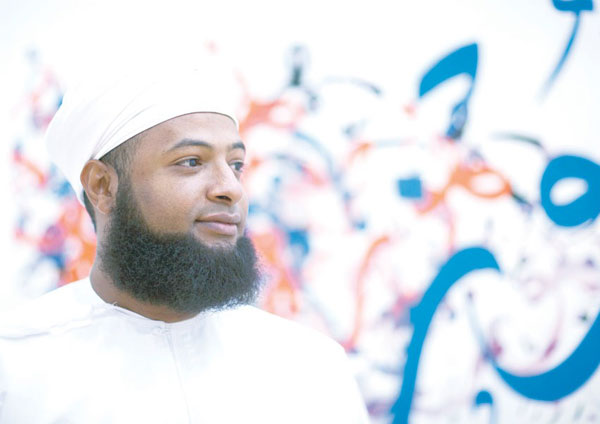Saleh gives calligraphy a new expressive form
Being one of the few artists in Oman to achieve international success, Saleh al Shukairi now stands as one of the biggest names in the local arts scene. His calligraphy work has been exhibited at major art fairs and galleries across the world, from Miami to Korea. But the zenith of his career so far has to be his calligraphy piece that stands on display for the public in London’s British Museum.
From an early age, his passion for the intricate details of Arabic calligraphy pushed him forward as an artist. “I started feeling I was connected with the Arabic script when I was young and so I aspired to learn the precise rules of the Arabic letters, their shapes and the way in which they should be written” Saleh remembers.
Art using Arabic calligraphy has enjoyed something of a boom over the past decade. The centuries-old tradition, where geometry and rules shape each letter of the script, are where the past and present meet. The contemporary methods that artists employ, however, have given calligraphy a new expressive form and relevance for a modern age.
Saleh says that when he was growing up and learning the art form, books on calligraphy were in short supply in Oman. This meant that he had to teach himself the rules of the art form, which led him to invent his own mediums. It is something that distinguishes his work today. It was only later in his life that Saleh received the academic tutorship he craved at the Omani Calligraphy Institute in Seeb, learning the art of Roqah and Nasikh forms of calligraphy.
Despite this academic experience in the subject, Saleh says he felt inspired by a different vision than his predecessors. “I started using all 28 Arabic letters in a way to prove that we can use the letters to express our feelings and to show a different view of the Arabic script,” he says.
Often the forms of the letters speak of freedom and an absence of borders. Their unrestricted, free form implies movement and action and Saleh says it is why his work fits into the category of performance arts, as much as painting does. “Sometimes the text can be brutal or provocative. The words may seem to be caught behind bars, imprisoned, prevented from escaping, or being read and deciphered.”
There is also a lyrical element behind the composition of the letters that are developed in layers on the canvas, accentuating the individualism of each letter and underlining their collective relationship. In the process of painting, the rhythm of music is often present, which can also be found in his work. “Usually I work with Islamic Nasheed music, which is a source of inspiration. In such instances it gives my imagination free reign,” he says.
Experimentation plays an important part in his multimedia work; he uses an array of tools from reed pens to shards of glass. The base of his work is equally eclectic, traditional canvas and paper sometimes but he is also open to industrial materials such as aluminium and zinc. Nature’s ingredients are also employed such as skin and plants.
This diverse form of media is just one reason that Saleh stands out in the highly competitive calligraphy arts scene, but he admits that it has been a difficult task. “Each artist must have a target and mine was to be an artist represented in global auctions, which Al Hamdolilah has happened,” he explains.
The reason for his success, he believes, is that art has consumed his life. He likens this passion to the relationship of a professional football player with the sport. Illustrating this, Saleh tells me that he made the decision to quit a well-paid job in the oil industry to follow his dream of becoming an internationally renowned artist.
He says the gamble paid off and in the two years he spent concentrating on his art full-time, Saleh earned more than his salary from sales of his artwork. Recently he made the decision of moving to Sohar to work full-time again, but this does not appear to have affected his art.
The stigma of unemployment and a lack of prestige in being an artist in Oman, he says, have generally held back many talented artists in the country from doing likewise. Other problems abound, which have hampered the growth of a progressive, dynamic arts scene in the county. “We don’t have any art museums or many galleries like other countries in the region,” he says. “The problem is that we don’t advertise our art abroad. If you look at our neighbours, they have functions and exhibitions opening every week and in Dubai there are 64 galleries. We have the budget, we just need to think of a new strategy to promote art in Oman.”
Making his name known outside Oman was achieved through stalwartness and out of the box thinking. “Yes, I have taken the decision of promoting my artwork myself, as I can’t depend on anyone else to do it for me,” he reflects. It appears to be working as his artwork was recently accepted onto the world renowned, London-based art mart website, The Auction Room.
Still, he believes his individual success will help build Oman’s reputation in the arts overseas and spur on other great artists to achieve similar international grandeur. “My success has given me more responsibilities and made Oman a presence worldwide in art. I am happy to help my colleagues in the arts in Oman to do the same by giving some courses and helping them onto the right path to success.”
 Saleh gives calligraphy a new expressive form
Saleh gives calligraphy a new expressive formSource: main.omanobserver.om
For the largest part ill handwriting in the world is caused by hurry.
(Lewis Carroll)



